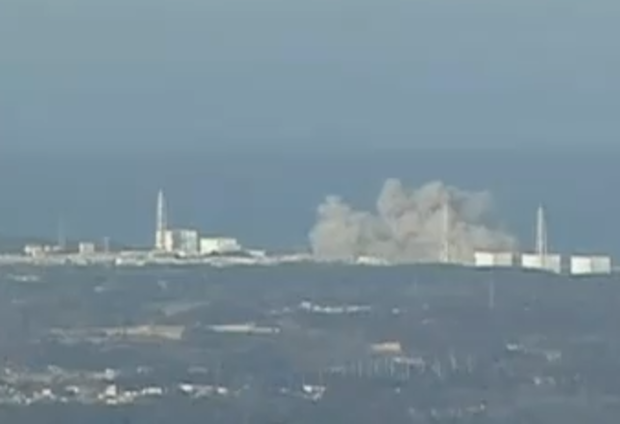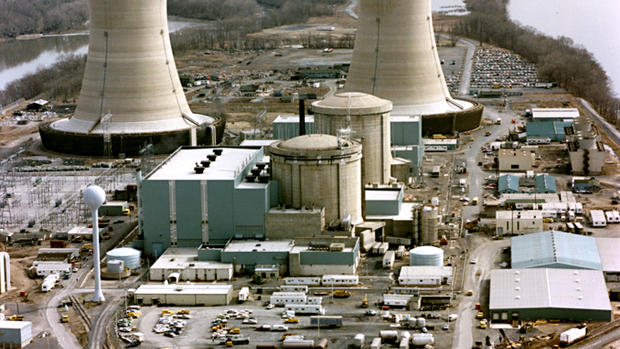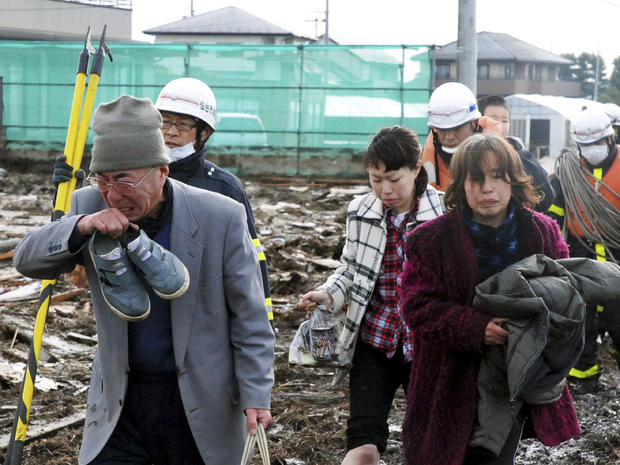Japan: Partial nuke meltdown, 2nd blast possible
Updated: 3:14 p.m. ET
Japanese officials were struggling Sunday with a growing nuclear crisis and the threat of multiple meltdowns, two days after the country's northeastern coast was savaged by a catastrophic earthquake and tsunami.
Partial meltdowns were already likely under way at two crippled reactors, and problems were also reported at two additional nuclear plants -- bringing the total number of troubled nuclear plants to four -- the New York Times reports.
The U.N. nuclear agency says Japan has declared a state of emergency at the Onagawa power plant, where higher-than-permitted levels of radioactivity were measured. The International Atomic Energy Agency says Japan informed it that the source of the radioactivity at the Onagawa power plant is being investigated. It said all three reactors at the plant are under control.
The term "meltdown" covers a wide range of outcomes, according to James Acton of the nuclear policy program at The Carnegie Endowment. The use of sea water to cool the fuel rods indicates the seriousness of the situation, and the likely failure of electrical and water pumping back up system, but a partial meltdown may not cause substantial amounts of radioactive material to pour into the environment. Even a even a full core meltdown doesn't necessarily mean a catastrophic radioactive event such as Chernobyl. "A major explosion of a reactor at the Daiichi plant is "almost inconceivable," Acton said. "I think that worst-case outcome is unbelievably unlikely in this case," Acton told CNN.
At this juncture, however, there is not enough information to predict the outcome at the Fukushima Dai-ichi nuclear complex.
Chief Cabinet Secretary Yukio Edano said Sunday that a hydrogen explosion could occur at Unit 3 of the Fukushima Dai-ichi nuclear complex, the reactor that could be melting down. That would follow a blast the day before in another unit at the same power plant, as operators attempted to prevent a meltdown by injecting sea water into it. He said operators had released slightly radioactive air from Unit 3 on Sunday, while injecting water into it hoping to reduce pressure and temperature to prevent a possible meltdown.
"Generator number 3 is now the most at risk for an outer container explosion like the one that took place a day ago on generator number 1," said CBS News correspondent Celia Hatton on Sunday in an interview with CBS' "Face the Nation." "That's when officials did the only thing they could to prevent the entire reactor from blasting open - they released a bit of radioactive steam to reduce pressure in that generator number 1, which led to a larger than expected explosion."
"So that's what we look for - could be coming from generator number 3 in the next day or so," Hatton told CBS' Bob Schieffer. "It seems likely that officials are going to have to do a similar operation on generator number 3, so unfortunately we're expecting more explosions from that nuclear plant."
Edano told reporters that a partial meltdown in Unit 3 of the Fukushima Dai-ichi power plant was "highly possible."
"At the risk of raising further public concern, we cannot rule out the possibility of an explosion," Edano said. "If there is an explosion, however, there would be no significant impact on human health."
Asked whether a partial meltdown had occurred, Edano said that "because it's inside the reactor, we cannot directly check it but we are taking measures on the assumption" that it was.
Special report: Disaster in Japan
Japanese nuke plant scare (Video)
How you can help
Submit your photos and video to CBSNews.com
More than 170,000 people had been evacuated as a precaution, though Edano said the radioactivity released so far into the environment was so small it didn't pose any health threats.
A complete meltdown -- the collapse of a power plant's systems and its ability to keep temperatures under control -- could release uranium and dangerous contaminants into the environment and pose major, widespread health risks.
Up to 160 people, including 60 elderly patients and medical staff who had been waiting for evacuation in the nearby town of Futabe, and 100 others evacuating by bus, might have been exposed to radiation, said Ryo Miyake, a spokesman from Japan's nuclear agency. The severity of their exposure, or if it had reached dangerous levels, was not clear. They were being taken to hospitals.
Hatton said that the government was giving some Japanese people - particularly those located within a certain proximity to the nuclear plant - iodine tablets to protect people against the affects of radiation.
"Not everybody is getting the iodine pills but they are trying to scan everybody for any effects of radiation," Hatton told Schieffer on Sunday. "Again, there are varying numbers as to how many people are affected by radiation. Actually at this point, Bob, it's very difficult to know whether their health has been affected in the long term. We simply don't know enough about the situation at the moment."
Japan struggled with the nuclear crisis as it tried to determine the scale of the Friday disasters, when an 8.9-magnitude earthquake, the most powerful in the country's recorded history, was followed by a tsunami that savaged its northeastern coast with breathtaking speed and power.
At least 1,000 people were killed -- including some 200 bodies discovered Sunday along the coast -- and 678 were missing, according to officials, but police in one of the worst-hit areas estimated the toll there alone could eventually top 10,000.
The scale of the multiple disasters appeared to be outpacing the efforts of Japanese authorities to bring the situation under control more than two days after the initial quake.
On the road to Sendai, Japan's Ground Zero
PHOTOS: Japan quake from above, before and after
Rescue teams were struggling to search hundreds of miles (kilometers) of devastated coastline, and thousands of hungry survivors huddled in darkened emergency centers cut off from rescuers and aid. At least a million households had gone without water since the quake, and food and gasoline were quickly running out across the region. Large areas of the countryside were surrounded by water and unreachable. Some 2.5 million households were without electricity.
Hatton said local residents were swarming to those places that did have electricity -- and working televisions -- to glean any information available.
"The televisions are on in every room. Any place that has electricity people are just gathered around watching these televisions 24 hours a day trying to find any news they can about the nuclear reactor," she said. "Of course here that means the difference as to whether they can go back to their family home or not."
Below: CBS News correspondent Bill Whitaker reports on challenges of the rescue effortJapanese Trade Minister Banri Kaeda warned that the region was likely to face further blackouts, and that power would be rationed to ensure supplies to essential facilities.
The government doubled the number of troops pressed into rescue and recovery operations to about 100,000 from 51,000, as powerful aftershocks continued to rock the country, including one Sunday with a magnitude of 6.2 that originated in the sea, about 111 miles (179 kilometers) east of Tokyo. It swayed buildings in the capital, but there were no reports of injuries or damage.
Unit 3 at the Fukushima plant is one of the three reactors that had automatically shut down and lost cooling functions necessary to keep fuel rods working properly due to power outage from the quake. The facility's Unit 1 is also in trouble, but Unit 2 has been less affected.
On Saturday, an explosion destroyed the walls of Unit 1 as operators desperately tried to prevent it from overheating and melting down.
Without power, and without plant pipes and pumps that were destroyed in the explosion of the most-troubled reactor's containment building, authorities resorted to drawing seawater mixed with boron in an attempt to cool the overheated uranium fuel rods in Unit 1. Boron disrupts nuclear chain reactions.
The move likely renders the 40-year-old reactor unusable, said a foreign ministry official briefing reporters. Officials said the seawater will remain inside the unit, possibly for several months.
Robert Alvarez, senior scholar at the Institute for Policy Studies and former senior policy adviser to the U.S. secretary of energy, told reporters that the seawater was a desperate measure.
"It's a Hail Mary pass," he said.
He said that the success of using seawater and boron to cool the reactor will depend on the volume and rate of their distribution. He said the dousing would need to continue nonstop for days.
Another key, he said, was the restoration of electrical power, so that normal cooling systems can operate.
Edano said the cooling operation at Unit 1 was going smoothly after the sea water was pumped in.
He said radiation levels just outside the plant briefly rose above legal limits, but since had declined significantly. Also, fuel rods were exposed briefly, he said, indicating that coolant water didn't cover the rods for some time. That would have contributed further to raising the temperature in the reactor vessel.
At an evacuation center in Koriyama, about 40 miles (60 kilometers) from the troubled reactors and 125 miles (190 kilometers) north of Tokyo, medical experts had checked about 1,500 people for radiation exposure in an emergency testing center, an official said.
On Sunday, a few dozen people waited to be tested in a collection of blue tents set up in a parking lot outside a local gymnasium. Fire engines surrounded the scene, with their lights flashing.
Many of the gym's windows were shattered by the quake, and glass shards littered the ground.
"First I was worried about the quake, now I'm worried about radiation. I live near the plants, so I came here to find out if I'm OK. I tested negative, but I don't know what to do next," said Kenji Koshiba, a construction worker.
A steady flow of people -- the elderly, schoolchildren and families with babies -- arrived at the center, where they were checked by officials wearing helmets, surgical masks and goggles.
Officials placed Dai-ichi Unit 1, and four other reactors, under states of emergency Friday after operators lost the ability to cool the reactors using usual procedures.
An additional reactor was added to the list early Sunday, for a total of six -- three at the Dai-ichi complex and three at another nearby complex. Local evacuations have been ordered at each location. Japan has a total of 55 reactors spread across 17 complexes nationwide.




